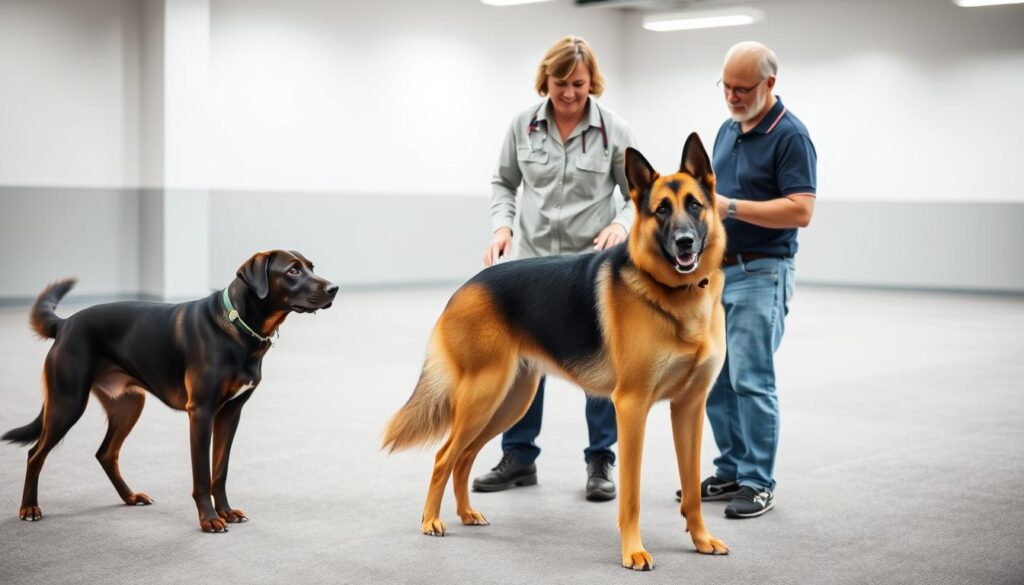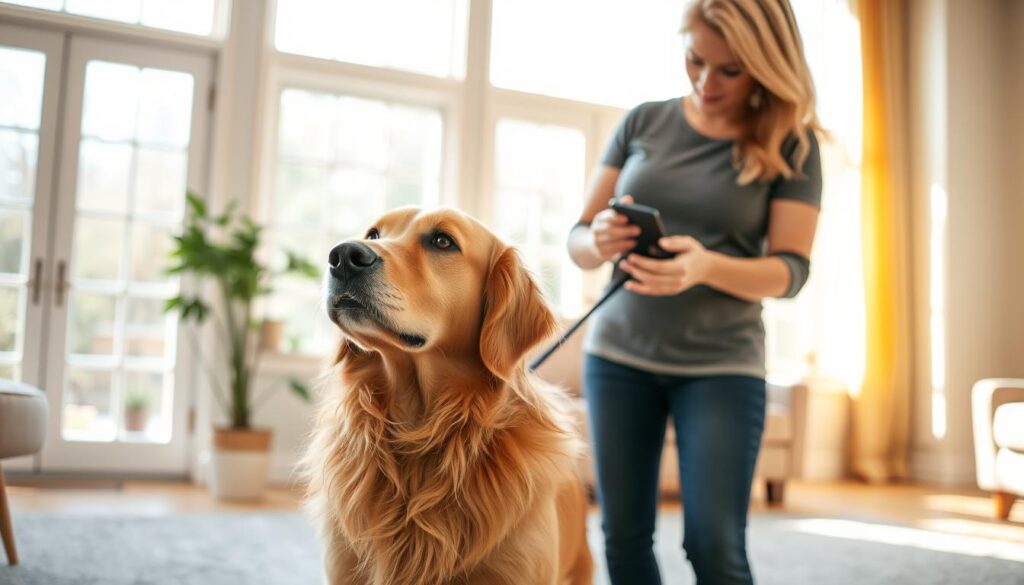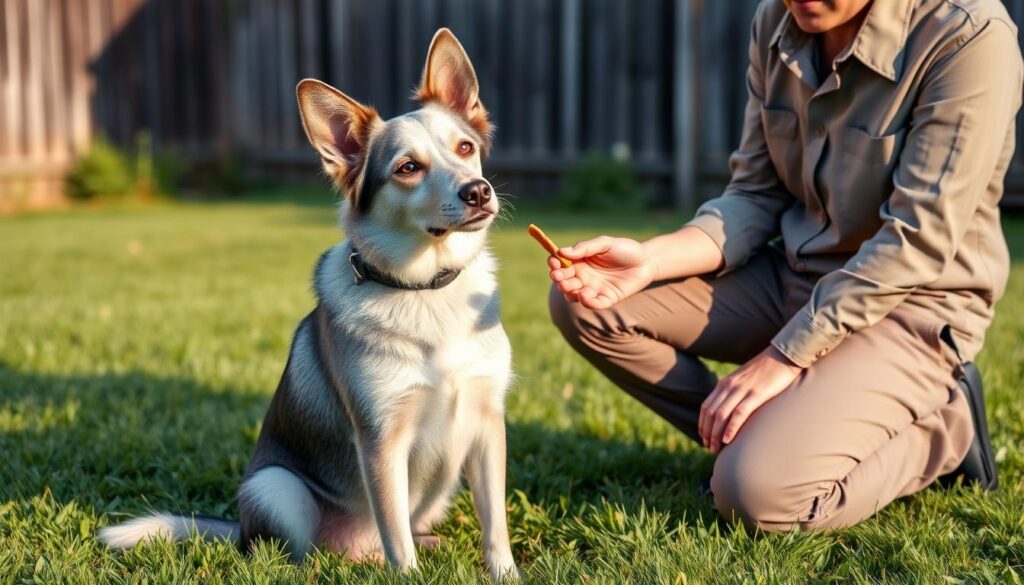Wondering if you can teach an old dog new tricks? The answer is yes, adult dogs can be trained.

It’s never too late to start. Training them requires patience, understanding, and the right approach.
With the right mindset, your dog can learn new skills and behaviors, no matter their age. The key is to recognize that adult dogs can be trained and understand their learning needs.
Training adult dogs has many benefits, like improving their behavior and strengthening your bond. By understanding that adult dogs can be trained, you can unlock their full potential. This makes your relationship with them more rewarding.
Whether you want to address specific behavioral issues or engage your dog’s mind, training is a great way to achieve your goals.
Introduction to Training Adult Dogs
Starting to train your adult dog? Remember, every dog is unique. They have their own strengths, weaknesses, and learning style. By recognizing that training adult dogs is possible, you can tailor your approach to meet their needs.
With persistence, positive reinforcement, and the right training methods, your dog can thrive. They can become a well-behaved, loyal companion.
Key Takeaways
- An adult dog can be trained with patience and the right approach
- Training adult dogs requires understanding their learning capabilities and needs
- Can an adult dog be trained is a common question with a positive answer
- Training adult dogs offers numerous benefits, including improved behavior and a stronger bond
- Every dog is unique, with their own strengths, weaknesses, and learning style
- Positive reinforcement and the right training methods are essential for successful training
- Training adult dogs is a great way to unlock your dog’s full potential
The Truth About Adult Dog Training: Debunking Common Myths
Many think older dogs can’t learn new tricks. But this is not true. With the right methods, training older dogs works just as well as training puppies. Adult dogs often focus better and are less distracted than younger ones.
Adult dog training helps build on what your dog already knows. It’s rewarding to see them improve and learn new things. This strengthens your bond and boosts your dog’s happiness.

- Be patient and consistent in your approach
- Use positive reinforcement techniques to encourage good behavior
- Keep training sessions short and fun to avoid overwhelming your dog
By following these tips and being supportive, you can help your dog learn and grow, no matter their age.
Advantages of Training Adult Dogs vs Puppies
Many owners find that adult dogs are easier to train than puppies. Adult dogs can focus better during training. They have already developed their personalities, making it easier to understand their strengths and weaknesses.
Training adult dogs is more efficient because they can learn from their life experiences. They can pick up new skills and behaviors faster than puppies. This is because they have already developed their cognitive abilities.
Some of the key benefits of teaching adult dogs include:
- Improved focus and attention during training sessions
- Established personalities, making it easier to understand their needs and behaviors
- Ability to learn from life experiences, making training more efficient
- Faster pickup of new skills and behaviors compared to puppies

Training adult dogs has many advantages over training puppies. By understanding these benefits, you can create a more effective training plan. This makes the training process more enjoyable and rewarding for both you and your pet.
Understanding Your Adult Dog’s Learning Capacity
When you think about training an adult dog, it’s key to know their learning style. Adult dogs have their own mental, physical, and emotional traits. These traits affect how they learn and react to training. By understanding these, you can adjust your training to fit your dog’s needs and skills.
Training adult dogs means looking at their mental and physical strengths. They can focus longer than puppies, which is great for detailed training. Their physical skills, like muscle memory, help them do complex tasks easily.
Mental and Physical Aspects
- Attention span: Adult dogs can stay focused for a long time, perfect for complex training.
- Problem-solving skills: Mature dogs think critically, making them good at solving new problems.
- Established muscle memory: Adult dogs move smoothly and efficiently, thanks to their developed physical skills.
Emotional Readiness
Emotional readiness is crucial for training an adult dog. A calm and confident dog learns better. A positive and supportive training space helps your dog feel at ease and open to learning.
Understanding your adult dog’s learning style and adjusting your training can unlock their full potential. Whether you’re training an adult dog or improving your skills, knowing your dog’s unique traits is essential for success.
Essential Training Methods for Adult Dogs
Many owners wonder if their adult dogs can learn new tricks. The answer is yes, with the right approach. Focus on positive reinforcement, consistency, and patience. These methods help your adult dog become well-behaved and obedient.
Using rewards and clear communication is key in adult dog obedience training. Treats, praise, and affection work well. Setting realistic goals and being patient with your dog’s progress is also vital. Yes, an adult dog can learn complex tasks with dedication and the right training.
Some essential training methods for adult dogs include:
- Positive reinforcement training
- Clicker training
- Agility training
These methods strengthen your bond with your dog and improve their behavior. Remember, every dog is unique. Be patient, consistent, and positive for successfuladult dog obedience training.
By following these essential training methods and tips, you can help your adult dog become a well-behaved and loyal companion. Whether you’re looking to address specific behavioral issues or simply want to improve your dog’s overall obedience, with patience, consistency, and positive reinforcement, you can achieve your goals and strengthen your bond with your adult dog.
Building a Training Schedule for Your Mature Dog
Training adult dogs needs consistency and flexibility. A good training schedule keeps your dog focused and motivated. This leads to faster progress and better results. It’s important to think about your dog’s unique needs and how they learn.
Start by setting daily training sessions that are fun and challenging. You can do obedience training, agility exercises, or simple tricks. The goal is to keep your dog engaged and give them a sense of accomplishment.
Daily Training Sessions
- Set aside 10-15 minutes each day for dedicated training sessions
- Focus on one or two specific skills or commands per session
- Use positive reinforcement techniques, such as treats and praise, to encourage good behavior
Weekly Progress Goals
As you train your dog, setting weekly goals is key. This helps you track your dog’s progress and adjust your training as needed. Aim for specific goals, like mastering a new command or improving their response to cues.
Adjusting Training Intensity
As your dog gets more confident and skilled, you can make your training sessions harder. You can increase the session length, add distractions, or introduce more complex commands. This keeps your dog challenged and helps strengthen your bond through adult dog training.
Common Challenges When Training Adult Dogs
Training older dogs can be tough. One big challenge is changing old habits. But, with patience and positive reinforcement, you can teach your dog new tricks.
Another hurdle is fear or anxiety. These feelings can make training hard. Use gentle methods to help your dog feel safe and confident.
Some common challenges when training adult dogs include:
- Existing habits that are hard to break
- Fear or anxiety that can impact learning
- Physical limitations that may affect mobility or energy levels
- Emotional baggage that can influence behavior
Understanding these challenges helps you train better. Be patient, consistent, and positive. Tailor your training to fit your dog’s needs and personality.
With the right approach, you can beat these challenges. This way, you and your dog can grow closer. You’ll help your dog become a well-behaved and happy companion.
Tools and Resources for Adult Dog Training
Teaching adult dogs needs the right tools and resources. As you start training your adult dog, it’s key to look at all your options. You’ll find everything from training gear to professional help and apps and videos.
Choosing the right tools is important. Training equipment like clickers and leashes help with good behavior. Professional trainers offer one-on-one help or group classes.
Training Equipment Essentials
- Clickers and treats for positive reinforcement
- Leashes and harnesses for walking and exercise
- Crates and beds for comfort and safety
Professional Training Options
Professional trainers create plans just for you and your dog. Online tools like apps and videos also help. They offer easy-to-follow training tips.
Recommended Training Apps and Videos
Apps and videos are great for extra training help. They have lots of tips and classes for adult dog training. Using these can make your training better and help your dog do well.
Success Stories: Real Examples of Trained Adult Dogs
Starting the journey of training mature dogs is exciting. Many adult dogs have shown great improvement through training. These stories prove that adult dog obedience training works well.
Some adult dogs have mastered basic commands like “sit” and “stay.” Others have even joined agility training and dog sports. These examples show that with effort and positive methods, adult dogs can learn and grow.
These success stories highlight the benefits of training mature dogs. Whether you aim to fix behavior issues or deepen your bond, adult dog obedience training is worth it. It’s a great way to improve your dog’s life and your relationship with them.
Important lessons from these stories are:
- Consistency and patience are key in training adult dogs
- Positive reinforcement is very effective in adult dog training
- Adult dogs can learn and change their behavior
Keep in mind that every dog is different. What works for one might not work for another. Stay dedicated to your training goals and be open to new methods. This way, you can help your adult dog reach their best and enjoy a stronger bond with them.
Creating the Perfect Training Environment for Your Adult Dog
Training adult dogs needs a well-structured environment for success. You should make a space that helps them learn, without distractions, and meets their needs. Set up a special training area at home or in your yard for your dog to focus.
Remember, consistency and routine are crucial when training adult dogs. Have a regular training schedule and stick to it. This makes your dog feel secure and builds trust in the training. A positive and focused atmosphere helps your dog overcome challenges and reach their best.
- Train in a quiet area or during less busy times of the day to avoid interruptions.
- Use positive reinforcement like treats and praise to encourage good behavior.
- Be patient and consistent, as adult dogs can be trained with time and effort.
By following these tips and creating a tailored training environment, your adult dog can thrive. Stay patient, consistent, and positive, and you’ll succeed in training your adult dog.
Conclusion: Embracing the Journey of Adult Dog Training
Adult dog training is rewarding for both you and your dog. It’s not true that “old dogs can’t learn new tricks.” This journey can make your bond stronger, improve your dog’s behavior, and make your life together happier and healthier.
By using positive training methods, you can unlock your dog’s full potential. With patience and dedication, you can overcome any challenges. This article has given you the tools to achieve great results with your mature dog.
To succeed, create the right training environment and stick to a routine. Celebrate your dog’s progress too. Embrace this journey for the amazing rewards of a well-trained adult dog. Let’s start on the path to a stronger, more loving relationship with your dog.
FAQ
Can an adult dog be trained or is training limited to puppies?
Absolutely, adult dogs can be trained. Puppies learn quickly because they are curious and eager. But adult dogs can also learn new things. With patience and the right methods, you can train an adult dog.
What are some of the key benefits of training an adult dog?
Training an adult dog has many benefits. It improves their behavior and obedience. It also strengthens your bond and communication.
How does the training process differ for adult dogs compared to puppies?
Training adult dogs is different from puppies in a few ways. Adult dogs have set habits that take more time to change. Their attention span is shorter, so training sessions need to be brief and focused.
Adult dogs might be more cautious or resistant to change. They need a gentle and positive approach. Despite this, they can learn new things quickly because of their life experiences.
What are some effective training methods for adult dogs?
Effective training methods for adult dogs include positive reinforcement. This means using treats, praise, and rewards. Consistency and repetition are also key.
Introduce new commands and behaviors gradually. Address any underlying issues or anxieties. Mix mental and physical exercise into the training routine.
How can I create the perfect training environment for my adult dog?
To create the perfect training environment, start by choosing a quiet, distraction-free space. Establish a consistent routine and schedule for training. Eliminate stress or anxiety sources during training.
Use positive reinforcement and reward-based techniques. Be patient, understanding, and adaptable to your dog’s learning pace.
What are some common challenges when training adult dogs, and how can I overcome them?
Common challenges include existing habits or behaviors that need changing. Fear or anxiety can also hinder training. Adult dogs may have shorter attention spans or find it hard to focus.
To overcome these, use desensitization and counterconditioning techniques. Tailor your training to your dog’s needs. Incorporate breaks and rewards to keep them engaged. If needed, seek help from a professional trainer.
